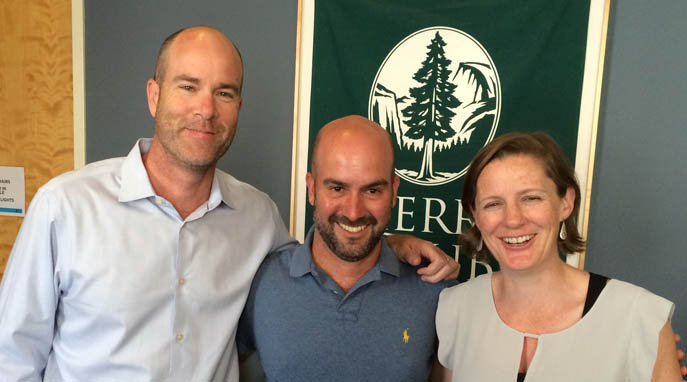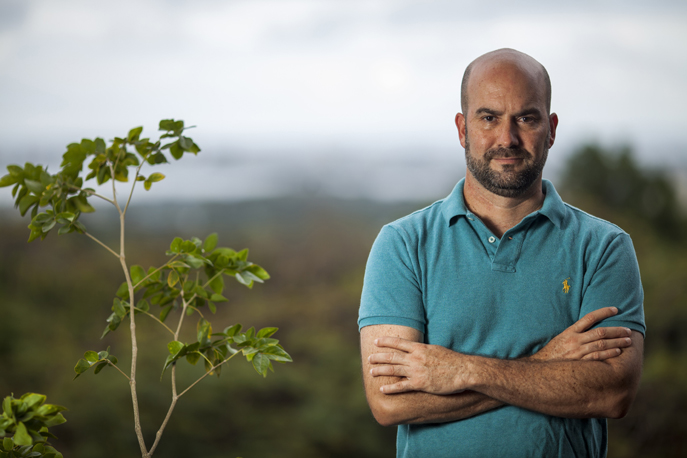Puerto Rico environmental activist and Sierra Club partner Luis Jorge Rivera Herrera has been awarded the 2016 Goldman Environmental Prize. "We nominated Luis Jorge for the Goldman Prize in recognition of his untold hours and years of work protecting Puerto Rico's most vulnerable coastal ecosystems," says friend and former Puerto Rico Sierra Club director Camilla Feibelman. "Without his deep integrity, ceaseless activism, and technical prowess, these leatherback sea turtle nesting beaches would not be protected today. It was an honor and a pleasure to work with this man whom I consider a good friend for over 10 years on this battle that finally ended in 2013."
Below, that's Sierra Club executive director Michael Brune, Rivera Herrera, and Feibelman at Sierra Club headquarters in San Francisco the morning of the Goldman Prize awards ceremony.

To support ongoing efforts to protect nesting beaches for leatherback sea turtles in Puerto Rico, you can make a donation here.
The following is here reproduced courtesy of the Goldman Environmental Prize.
Luis Jorge Rivera Herrera helped lead a successful campaign to establish a nature reserve in Puerto Rico’s Northeast Ecological Corridor—an important nesting ground for the endangered leatherback sea turtle—and protect the island’s natural heritage from harmful development.
Where the leatherback sea turtle calls home
The Northeast Ecological Corridor (NEC) covers 3,000 acres of prime oceanfront property along the north coast of Puerto Rico. In addition to its scenic and recreational value, it has enormous biological significance. The corridor is home to more than 50 rare, threatened or endangered species, some unique to the island, and its proximity to El Yunque National Forest, a UNESCO-designated biosphere reserve, adds to its natural value and uniqueness.
In the late 1990s, with promises to revitalize the area’s economy, developers proposed two megaresorts—3,500 hotel rooms and residential units, multiple golf courses, a shopping mall, and other urban construction—to be built in the corridor. These projects would have destroyed the corridor’s wildlife habitat, threaten the local water supply, and limit public beach access while ignoring the reality that other similar developments in Puerto Rico had failed to bring the economic opportunities that had been promised.
A life rooted in appreciation of nature
Born in Puerto Rico, Luis Jorge Rivera Herrera spent many childhood weekends at a coconut farm that had been owned by his family since 1873. When he was 8 years old, the government seized the family’s farm with plans to build a wastewater treatment plant on the land.
As a teenager, he enjoyed surfing. The hobby led him to the Northeast Ecological Corridor, whose scenery and natural beauty brought back memories of his family’s farm. He recalled the experience of seeing bulldozers tear up the cherished family farm—an experience that would form the foundation of his life-long commitment to protect the environment and hold the government accountable to citizen’s rights.
Rivera Herrera went on to study environmental science and built a career in environmental planning and management. In 1999, he came across a newspaper ad about the proposed megaresorts. Thanks to his professional training and personal experience growing up in the region, he knew the area’s recreational and environmental value—and was determined to not let the government pave over it.
Sixteen years and five governors later
Rivera Herrera and a group of close friends began volunteering their time to organize public opposition to the megaresorts. The campaign’s momentum shifted in 2005 with the arrival of a full-time organizer from the Sierra Club, which led to the formation of the Coalition for the Northeast Ecological Corridor. Newly energized, Rivera Herrera drafted a bill to protect the corridor as a nature reserve. The legislation sailed through the lower house of the Puerto Rican legislature, but was ultimately blocked by a handful of senators, one of whom would later be found guilty of bribery and corruption charges.
The bill had died, but by 2007, the Rivera Herrera and the coalition had built a formidable amount of public support for the protection of the corridor. This created a safe political environment for then-Governor Acevedo-Vilá to circumvent the legislature and sign an executive order designating the Northeast Ecological Corridor a protected nature reserve.
Puerto Rico elected a new governor in 2008, who ran on a platform of jumpstarting the economy through construction jobs. The megaresort developers contributed generously to his campaign, and soon after he was elected, in October 2009, Governor Fortuño repealed his predecessor’s designation, leaving the corridor vulnerable to development.
In 2012, Rivera Herrera and the coalition successfully worked with legislators to pass a new bill that designated all public lands in the corridor a protected nature reserve. With overwhelming public support for the corridor and his reelection at risk, Fortuño signed the bill into law. The coalition gained more momentum in April 2013, when the newly elected Governor García-Padilla expanded the corridor’s nature reserve designation to include privately owned land. At every step of the way in the 16-year battle, Rivera Herrera was there to challenge government corruption and advocate for the public’s right to demand protection for the environment.
Rivera Herrera and his coalition colleagues are now mounting a fundraising campaign to help the government purchase the remaining privately owned land in the corridor. They are also leading citizen participation in a plan to develop the corridor as an ecotourism destination, which will generate funding for wildlife management and restoration while revitalizing the local economy.
